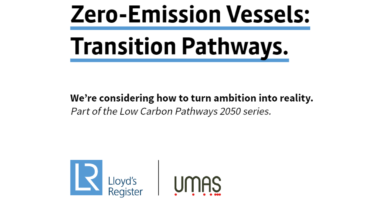Ships are capital intensive assets with typical operating lives of 20-30 years, longer for some types of ships.
Therefore, at maximum, we have only a generation and a half of ships to develop zero-carbon fuels and associated technologies that can power our ships safely and efficiently in the future. Zero-emission ships must enter the world fleet in 2030.
Now, it is our collective responsibility to collaborate with other stakeholders to ensure that the decarbonisation of our industry is achieved and that the IMO goal of reducing GHG emissions by at least 50% by 2050 becomes an immediate focus and goal. realistic, rather than just distant ambition.
In collaboration with the University Maritime Advisory Services (UMAS), we set out to understand the milestones and the facilitating factors within the time frame required to create the necessary conditions for the evolution of the different pathways towards decarbonization. We have considered how cost, operational profile and policy measures might influence this and have identified milestones over time regarding the safety, technical, social, economic and environmental aspects of potential zero emission vessels ( ZEV) and the associated supply of zero emission fuel options.
We start with a desirable future where the fuel mix in shipping will be dominated by zero-emission fuels in 2050, and we assess the conditions that must be created now to achieve this desired future.
Right now, there is too much uncertainty to decide on a route, fuel and technology for the future transition of the shipping industry. Therefore, we must consider all the key primary energy sources that would allow carbon-free fuels to enter the marine fuels market: renewable energy, bioenergy, and fossil fuels with carbon capture and storage (CCS). Although one of them may seem more likely than the other, we need to include all possible transition pathways and compare the different conditions to better understand the actions that can be taken now.
These pathways assume that fuels derived from an energy source will become the dominant fuels in 2050. While this implies that there are several differences between the pathways, it also means that there are several similarities.
With significant investment in short-term research and development, technologically all avenues provide solutions to reach the future with zero carbon emissions as technology readiness increases and, ultimately, costs are reduced throughout the transition . However, there is a need for action in the form of policies, regulations, financial incentives and end-user maritime transport incentives.
The 2020-2030 decade is the most important in terms of measures for the transition to a carbon-free future by 2050. To develop, test, scale and commercialize absorption of zero-emission ships, we must now establish
Collaborative joint ventures involving not only our own industry players, but also fuel technology companies, equipment manufacturers and energy developers from other industries outside of shipping.
ACCESS TO THE DOCUMENT:

